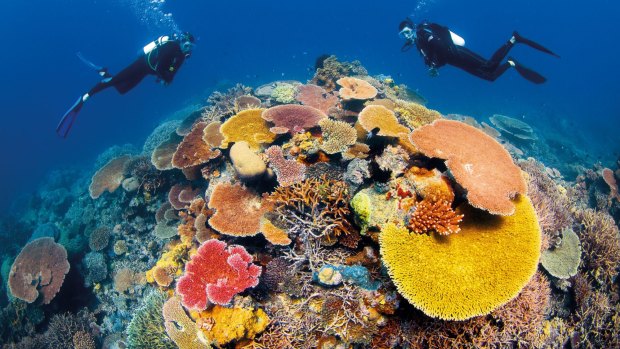This was published 8 years ago
Great Barrier Reef: Authorities must check reef islands says World Wildlife Fund
By Tony Moore
Coral on reefs north of Townsville must be checked for oil that has become stuck to coral, World Wildlife Fund's reef campaigners said on Monday.
WWF-Australia spokesman Richard Leck said reefs in low-lying coastal areas must now be checked after clean-up crews have begun to remove clumps of oil from beaches north of Townsville after oily film has drifted north.

Diving in The Great Barrier Reef.Credit: Tourism and Events Queensland
"If the spill drifted across reefs at low tide then it's almost certain there are now tar balls stuck to coral," Mr Leck said.
"It's possible to remove these sticky tar balls from reefs but if nothing is done they can take years to degrade," he said.
"We call on authorities, based on the modelling of tides and currents, to check those reefs in the path of the spill.
Oil clumps have drifted north in Great Barrier Reef Marine Park waters and are being removed from four beaches from Hinchinbrook Island south to Townsville.
This follows an un-reported oil spill south of Townsville 10 days ago.
"Small dinner plate size" clumps of oil are washing ashore on Taylors Beach near Lucinda, Mulligan Bay on Hinchinbrook Island, Forrest Beach near Ingham and in the Palm Island Group," Mr Leck said.
Great Barrier Reef Marine Park Authority and Maritime Safety Queensland staff are removing the clumps of oil from the four beaches as they wash in on the tide.
Both authorities says there are no reports of oil on Pandora Reef although it is unclear if officers have yet checked the site.
Townsville police have blocked access to the beaches while the clean-up – expected to take several days – is completed.
The fourth beach – Taylors Beach near Lucinda - was added to the clean-up sites on July 26.
Maritime Safety Queensland is trying to trace the ship that released the oil and has taken samples from nine of the 10 domestic tankers that sailed past Cape Upstart on July 16.
Four tankers that have since headed overseas will also be tested.
A Townsville fisherman reported "an 800 metre diameter" oil spill off Cape Upstart to the Townsville Coast Guard on July 16.
By July 17 it had broken into clumps of oil film that spread over a 30 kilometre by five kilometre area in water near Townsville.
On July 18 MSQ chairman Patrick Quirk said the oil would find its way onto local beaches and that MSQ would eventually find the ship which released the oil.
On July 24 oil was reported at three beaches – Mulligan Bay on Hinchinbrook Island, Forrest Beach near Ingham and on Palm Island.
People are being urged to stay away from affected beaches.
So far no wildlife has been affected and there's been no large-scale spill affecting the Great Barrier Reef.
-with Australian Associated Press